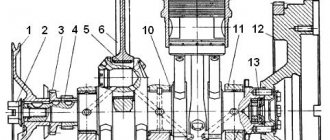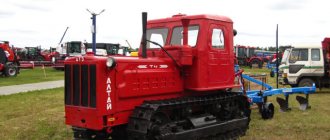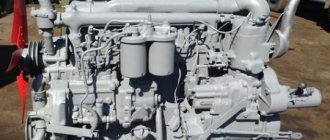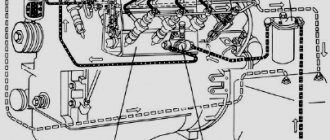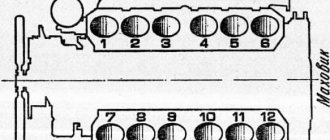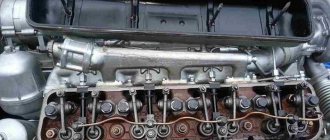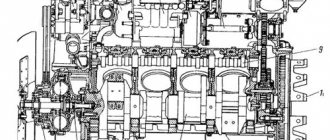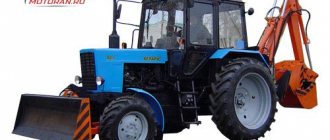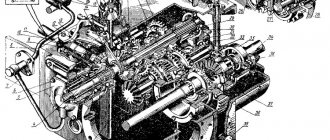Domestic agricultural machinery is equipped with different types of engines. The A 41 diesel engine is one of the types of units that have become widespread. The main manufacturer is the Altai Motor Plant, operating in Barnaul.
A41 is a series that features naturally aspirated diesel engines equipped with four cylinders. Construction and agricultural machinery is where such units are most often used. The unit is distinguished by its unpretentiousness and high build quality. Another advantage is good maintainability. Due to this, consumers give preference to such units.
The following technical characteristics of the A41 engine are present in stock versions:
- 12 thousand engine hours of declared working life.
- Supply of two gear hydraulic pumps, with the addition of a crankshaft drive with a gear type transmission.
- 2 valves in the gas distribution mechanism.
- DC unit, designated 214A1, 7=G304.
- In winter, DS-8 oil is used, in summer - DS-11.
- The use of a liquid cooling system for the engine.
- 1.62 kWh – fuel consumption indicator.
- 412 Nm at 1300 rpm – torque level.
- 16 is an indicator for the standard compression ratio.
- Each individual cylinder has a 130mm diameter.
- 140 mm piston stroke length.
- Cylinders installed vertically.
- The total number of cylinders is 4. The indicator is different if we consider, for example, the ZMZ 41 engine.
What does the A 41 engine look like?
Engine A41: where can it be installed
This type of unit is present in
:
- Pumping units.
- Graders.
- Power plants.
- Excavators.
Connection with other types of equipment is also allowed if plant representatives do not object. The engine is used on tractors of the T-4A, DT-75M, T-4 series. The GAZ 41 engine also became popular.
Main features, overview information
If the engine is 90-horsepower, then it will have a cylinder volume of 7.43 liters. Thanks to this, serious power appears even at relatively low speeds. The developers are trying to follow the latest trends characteristic of the motorcycle industry. Therefore, a direct injection system was built into the control system unit. This means that only electronic systems control the fuel supply.
Another important feature is the use of a gas distribution mechanism with two valves. Engineers used this part to give maximum efficiency to their engine. The output and efficiency of the device have also improved, which is proven by numerous photos; the A 41 engine gets better with each modification.
High-strength cast iron sleeves add to the overall reliability of the unit. Their surface is treated with a special method - vertex honing. The cooling system becomes more sophisticated, and the overall working life increases. But we must remember about weight gain. The main element of the cooling system is the oil-liquid heat exchanger. It cools the engine equally well both in idle mode and in the presence of additional loads. Engine stability has been greatly improved due to the fact that it is now able to maintain a stable, comfortable temperature. This helps the clutch of the A 41 engine work better.
What other parameters deserve attention?
Among the interesting parameters is that the valves rotate during engine operation when they are acted upon by their own springs. This is due to vibrations that accompany standard operating conditions. Valve engines are considered more reliable, so this design can be considered an advantage of the device.
The heaviest loads usually fall on the camshaft. Therefore, its hardening involves the use of high-frequency currents. The operation of the mechanism is ensured by 12 cams and 7 necks, which are located inside.
The unit begins to move when interacting with the crankshaft. Gear transmission takes part in this process.
The environmental friendliness of the power unit is another issue that the developers have seriously thought about. Units that have left production have no violations in the direction of emission of harmful substances into the atmosphere. Therefore, the lubrication system of the A 41 engine remains reliable.
Regarding modifications
Depending on what special equipment is used, various engine modifications are used.
The main models will be:
- On the DT-75 tractor, A-41I, SI, S are used.
- A-41 D is suitable for forklifts and rollers.
- A 41-G – modification for drilling rigs and graders, asphalt pavers.
- Pumping stations require the use of the A-41 B series.
Using a tractor in technology
Basic models are often installed on tractors or any other equipment agreed with the manufacturer. The motor is available in more than 11 modifications. The following additional equipment can be used:
- Enlarged heat exchanger for the engine oil cooling system.
- Pre-starting electric torch heater.
- Pneumatic compressor.
- Silencer.
- Clutch block coupling with modernization.
- Two hydraulic pumps instead of one.
The location of the cylinders is also different for modifications. The latest models have an in-line layout, thanks to which the rated power increases to 100 horsepower. The torque reserve has been increased to 20%. The clutch adjustment in the DT 75 has a special effect. The A41 engine shows its advantages under various circumstances.
About maintenance
There should not be any serious problems when servicing the units. The driver can perform the work independently:
- Oil pressure and temperature are the only indicators that require constant monitoring. The current lubrication level requires periodic monitoring. The oil filter needs to be washed from time to time. Every 240 minutes the fluid used must be replaced.
- Every day the engine is serviced by different shift workers. Or the event is held every 8-10 engine hours. The tightness of connections and fastening elements must be checked and cleaned from dirt and dust. Separately monitor extraneous noise, adding fuel and water.
The cooling system cannot do without regular maintenance. The system must be flushed to remove scale. Additional sealing is applied when a leak appears.
Engine maintenance must be performed promptly
Description of faults
Among the most common problems are the following:
- The engine overheats, making further operation impossible. The cooling system of the unit usually uses water. This leads to precipitation or the appearance of calcium deposits on the walls. The condition of the radiators is examined carefully before increasing the temperature. The parts are thoroughly cleaned and the accumulated scale is removed. Only sometimes it is necessary to replace a thermostat or a broken pump.
- Increased oil burnout. For example, when the valve cover loses its seal. Such covers are installed separately for each group of cylinders. But in the latest modifications, such problems have been solved.
- Working with noticeable vibration. In this case, you cannot do without opening the engine. Then the piston and crankshaft are checked. Balancing bearings require proper replacement if they fail, and this happens often.
- Interruptions in engine operation, problems with starting. The breakdown often occurs due to a clogged fuel filter. The injection system also becomes a source of unpleasant consequences. First, the fuel system is carefully inspected. After this, the engine is opened.
Malfunctions
| FAULT | CAUSE |
| The engine overheats, which makes it impossible to operate the equipment. | The cooling system of this power unit uses mainly water, which can lead to sedimentation or the appearance of calcium deposits on the radiator honeycombs. That is why, when the operating temperature increases, it is necessary to inspect the condition of the radiators, rinse them, removing the corresponding scale. In some cases, it is necessary to replace the thermostat or replace a broken pump. |
| Increased oil loss is noted. | The reason for this may be a valve cover that has lost its seal, which is installed separately on each group of cylinders. A similar problem was solved in the latest modifications of this engine, where German crankcase blocks were used. |
| The A 41 engine has lost most of its power and is running with noticeable vibration. | It is necessary to open the power units and check the condition of the pistons and crankshaft. Quite often balancing bearings fail and require appropriate replacement. |
| There are interruptions in engine operation and problems with starting are noted. | The cause of such a breakdown may be a clogged fuel filter or problems with the injection system. It is necessary to first inspect the condition of the fuel system, and then open the engine. |
Specifications
A 41 is a series of four-cylinder naturally aspirated diesel engines. Their main purpose is use in construction equipment and agricultural machines. A 41 is a high-quality, unpretentious, durable unit, easy to operate and has good maintainability, and this characteristic of A 41 engines has allowed it to gain consumer recognition.
A41, removed from the DT-75 tractor:
Technical characteristics of the A 41 engine in the stock version:
- Engine weight A 41: 930 kg.
- Motor dimensions: length 1425 mm, width 827 mm.
- Cylinder block design: cast iron BC.
- Fuel supply: direct diesel injection method.
- Cylinder operation algorithm: 1 – 3 – 4 – 2, counting is carried out from the engine fan.
- Volume: 7.43 liters.
- Developed power: up to 90 horsepower.
- Number of revolutions according to the passport: 1750 rpm. in a minute.
- Cylinders: 4.
- Cylinder arrangement: mounted vertically.
- Piston stroke length: 140 mm.
- Individual cylinder diameter: 130 mm.
- Standard compression ratio A41: 16.
- Developed: 412 Nm at 1300 rpm.
- Fuel consumption: min. 1.62 kWh.
- Cooling system of diesel engine A 41: liquid.
- Oil used: DS-11 in summer, DS-8 in winter.
- Motor generator: DC unit 7=G304, 214A1.
- Number of timing valves: 2
- Hydraulic pumps: 2 gear pumps, driven from the crankshaft by a gear-type transmission.
- Declared engine life: 12 thousand hours on the latest engine models.
Review and features - A-41 engine
The 90-horsepower engine has a respectable cylinder capacity of 7.43 liters, which allows the base model A 41 to produce such power at relatively low speeds, about 1750. Following engine development trends, the developers introduced an electronic direct injection system into the A 41: fuel supply is completely controlled electronically.
An important feature of the A 41 engine is its two-valve gas distribution mechanism. Engineers used it to give the engine the highest possible efficiency, output and efficiency.
To make the unit more reliable, the A 41 uses high-strength cast iron liners, the surface of which is treated by top honing. This increases the life of the motor, coupled with a well-thought-out cooling system (although the weight also increases). As such, an external oil-liquid heat exchanger is used, which cools the engine equally well both in idle mode and at maximum loads. By maintaining a stable, comfortable operating temperature, engine reliability has been further improved.
An interesting feature of the engine: during engine operation, the valves are able to rotate under the influence of their own springs and vibrations accompanying the engine operating cycles. This can be attributed to the advantages of the design, since the valve stem wears more evenly (although the chamfer of the valve plate also wears out).
The engine camshaft must withstand heavy loads, so it is hardened with high-frequency currents. The camshaft has 7 journals and 12 cams that ensure the operation of the mechanism. The unit is driven by the crankshaft through a gear transmission.
The developers also took care of the environmental friendliness of the power unit: the engine released from the AMZ workshops complies with the domestic standard R 41.96-2005 for the absence of violations in the emission of pollutants and harmful substances.
Description
The displacement of this four-cylinder diesel engine A 41 is 7.43 liters, which allows it to provide power of 90 horsepower at 1750 rpm. The A 41 engine has a direct injection system, which in the latest versions is fully electronically controlled.
A design feature of this power unit is a two-valve gas distribution mechanism, which ensures maximum efficiency and output. To increase the reliability of the design, the A 41 diesel engine used special liners made of cast iron with surface treatment using top honing technology.
The cooling system used can significantly reduce the operating temperature, which has a positive effect on the reliability of this power unit. An external liquid-oil heat exchanger is used to cool the oil, allowing the power unit to operate at maximum loads and under difficult operating conditions.
Motor modifications
The engine is available in various variations designed to work with certain special equipment.
Main models:
The basic engine model and modifications are installed on tractors and other equipment, in agreement with the manufacturer. In total, there are more than 11 engine variations, differing mainly in additional equipment. You can put:
- two hydraulic pumps;
- upgraded clutch block coupling;
- muffler;
- pneumatic compressor;
- pre-start electric torch heater;
- enlarged heat exchanger of the engine oil cooling system, etc.
Engine modifications A-41SI1, 02 and 03 differ from each other in the arrangement of the cylinders: the latter received an in-line layout, due to which the nominal power developed by the engine increased to 100 forces, and the torque reserve - up to 20%, compared to its counterparts. According to the plant catalogue, popular tractors of the DT-75 series are equipped with A 41I, SI, S engines.
Since 2001, engines have been assembled with their own heads for individual cylinder groups, which has improved the reliability of the gas joint and reduced engine oil consumption “waste.” In 2003, a modification was created with electric start, which increased the service life. And in 2012, the crankcase block of the A 41 engine was replaced with licensed German crankcases, which made the engine even more reliable.
Block crankcase:
The A-41 has a related engine, the A-01, also designed to operate on special equipment. Unlike the A-41, the second engine has 6 cylinders.
Modifications
Over the years that this engine has been on the assembly line, it has undergone minor changes that have significantly simplified equipment maintenance, improved its reliability, reduced fuel consumption and increased power.
For example, modification A-41SI-03 has an in-line arrangement of cylinders, which made it possible to increase the rated power from 90 to 100 horsepower. This power unit has a torque reserve coefficient of 20%, while for modifications A-41SI-1 and A-41SI-02 this figure is 15%.
Since 2001, in the manufacture of these power units, individual cylinder heads have been used for each group of cylinders, which in turn has increased the reliability of the gas joint seal and reduced oil consumption during combustion.
The engine, while on the assembly line, was improved, receiving various electronic control units. In 2003, this power unit began to be equipped with an electric starter, which increased its service life. In 2012, under license for the A 41 diesel engine, German crankcase blocks began to be installed, which increased the reliability of the engine.
A total of 11 different modifications were produced, most of which are a basic engine with additional attachments installed on it. So, for example, it is possible to install two hydraulic pumps, a belt pneumatic compressor, an additional generator, an enlarged liquid-oil heat exchanger designed for oil cooling, a modernized clutch and a number of other elements.
Maintenance
As already mentioned, the A 41 and its modifications are unpretentious in terms of operating conditions and service. A qualified technician can easily handle routine maintenance tasks on his own.
In fact, for long and uninterrupted operation of the engine, it is necessary, mainly, to monitor the oil temperature and pressure in the oil line, not allowing the lubricant level to fall below a critical level, and flush. Oil changes are carried out regularly, every 240 engine hours.
An important regular operation is clutch adjustment, since with gradual wear of the disc linings, the outlet clearances of the middle disc and the free play of the clutch increase. Schematic design of the clutch using the example of that in the DT-75 tractor:
This is a dry double-disc clutch of a permanently closed type. Adjustment of the DT 75 clutch with the A 41 engine should be carried out, if necessary, based on the test result, approximately every 240 operating hours.
Over time, it may also be necessary to adjust the valves of the A 41 engine. A gap of 0.25 ... 0.3 mm is allowed for both valves of this engine.
The motor should also be serviced every shift, at the end of the shift or before the start. The current service interval is about 10 engine hours. The set of manipulations includes:
- cleaning the engine from dirt and accumulated dust;
- checking fastenings and tightness of joints;
- control of the absence of extraneous noise;
- checking for fuel, water and engine oil leaks.
- The engine cooling system should also be regularly maintained. The set of service operations includes:
- descaling from the cooling unit, flushing the system;
- checking for leaks and sealing weak points of the radiator, if necessary.
TRACTOR DT-75M.
FEATURES OF DISASSEMBLY AND ASSEMBLY OF THE A-41 ENGINE Tractor DT-75M.
Removing the cylinder head of the A-41 engine Remove the cylinder head only to troubleshoot parts of the liner-piston group, cylinder head gasket, valves, or replace the head itself:
a) drain the coolant from the engine cooling system;
b) disconnect all fuel lines from the head, clean their internal cavities from dust and dirt;
c) disconnect the decompressor rod and remove the cylinder head cap;
d) remove the nozzles, protecting the nozzles from impacts and clogging of the holes;
e) remove the gas distribution transmission mechanism and remove the rods;
f) loosen the cylinder head fastening nuts, following the same sequence as when tightening (Fig. 79), then unscrew them;
g) remove the cylinder head from the engine and check it, paying attention to the tightness of the plugs;
h) if necessary, carefully remove the cylinder head gasket to avoid damaging it;
i) check the condition of the cylinder liners and close the cylinder openings to protect them from dust and dirt.
Rice. 79. Sequence of tightening the cylinder head nuts
Grinding in engine valves A-41
Grind in valves if there is no tightness at the valve-valve seat interface:
a) clean the cylinder head from oil and carbon deposits and put marks on the valve plates so that when assembling, be sure to install them on their seats;
b) remove the valves, clean the valves and valve seats from
carbon deposits, rinse in kerosene and inspect to determine the extent of repair.
It is possible to restore the tightness of the valve by grinding in the presence of minor wear and small holes on the chamfers if the valve plate is not warped and there are no burns on the chamfers of the valve and seat. If these defects are present, grinding should be preceded by grinding the valve seats or replacing faulty ones with new ones;
c) clean the inlet and outlet channels of the cylinder head and rinse with diesel fuel;
d) mix the lapping paste thoroughly. The paste should consist of a mixture of micropowder M20 or M14 according to GOST 3647-71 with motor oil and stirred until creamy. In the absence of mechanical mixing, micropowder is capable of settling;
e) apply a thin, even layer of paste to the valve chamfer, lubricate the valve stem with clean engine oil and put it in place; f) lightly pressing the valve plate, turn the valve 1/3 turn (using a special tool), then in the opposite direction - 1/4 turn. Do not grind in a circular motion;
g) periodically lifting the valve and applying new portions of lapping paste to the chamfer, continue lapping until a continuous matte belt with a width of at least 1.5 mm appears on the chamfers of the valve and seat. Breaks in the matte strip and the presence of scratches on it are not allowed (Fig. 80);
h) after finishing the grinding, wash the valves and seats with kerosene, wipe dry, install the valves and springs. their places;
i) check the tightness of the valve grinding by pouring kerosene alternately into the inlet and outlet channels and keeping it in them for two minutes; leakage or seepage of kerosene when turning to any angle is not allowed. ,
It is allowed to check the quality of lapping using a pencil. To do this, apply six to eight lines across the chamfer of the ground valve with a soft graphite pencil, then carefully insert the valve into the seat and, pressing firmly, turn it 1/4 turn. All lines on the working chamfer must be erased.
If the test results are unsatisfactory, repeat the grinding.
Rice. 80. Location of the matte belt on the ground valve of the A-41 engine
contents .. 71 72 ..
Typical faults
The motor has some characteristic problems.
- Overheat.
The engine cooling system uses mainly water as a coolant, which leaves calcium deposits on the radiator honeycombs and sediment in the pipes and cavities of the system. Therefore, you should regularly check the condition of the radiator and flush it, especially if the engine is expected to be operated under high loads. Sometimes, in advanced cases, it is necessary to change a failed pump or a thermostat on the A 41 engine that has stopped working.
- Abnormally high consumption of engine oil due to waste.
The reason for this is a leaky valve cover, which is specific to a separate cylinder group. It is to correct this shortcoming that the new models use German-made crankcase blocks.
- Loss of engine power, strong vibrations during engine operation.
The probable cause is a defect in the crankshaft assembly or pistons. You should also check the balancing bearings; they tend to break and then have to be replaced.
- Poor engine starting, interruptions in operation.
The reasons for this may be problems with the injection system or a fuel filter clogged with dirt. You should diagnose the fuel system, clean or replace the filter, and if this operation does not have an effect, open the engine and check the internal components.
Tuning
In some situations, the A41 engine may not have enough power. As in “civilian” engines, there are some technical techniques that allow you to extract increased power from the power plant.
- Installation of turbines from 440 series engines.
This is a complex operation, which also requires the installation of connecting rods and a lubrication system that correspond to the new characteristics of the engine. If these requirements are met, the engine becomes capable of delivering up to 145 horsepower, while maintaining the standard engine life.
- Flashing.
Some gains can be achieved through purely software manipulations by reprogramming the electronic engine control device.
Important: it is highly advisable to install more efficient injectors, since the standard ones may not be able to cope with the load.
In this way, 5-10 more horsepower is added to the characteristics of the A 41 engine than in the stock version.
Engine repair A 41. Page 3 of 6
Questions can only be asked after registration. Please login or register.
Beautiful
You can ride this tractor in a suit and tie
Thank you I already have the pump
Now I’m converting it to a starter start. I changed the crown to 119 teeth, bought an adapter plate, and a KAMAZ starter 8912.3708. The crown is marked 41с-0403-10. The entire set is recommended by the Altai Motor Plant.
Chief Mechanic, How much did this modification cost and where can I get this kit?
Chief Mechanic, How much did this modification cost and where can I get this kit?
Is it possible to install a YaMZ-236D piston on the A-41 engine.
Now I’m converting it to a starter start. I changed the crown to 119 teeth, bought an adapter plate, and a KAMAZ starter 8912.3708. The crown is marked 41с-0403-10. The entire set is recommended by the Altai Motor Plant.
I really want to get rid of the PD-10, but when you think about removing the flywheel, the desire immediately goes away
I really want to get rid of the PD-10, but when you think about removing the flywheel, the desire immediately goes away
Please tell me if anyone knows. This is the problem: the engine suddenly started to heat up, the manifold got red hot, we turned it off and after that we can’t start it.
